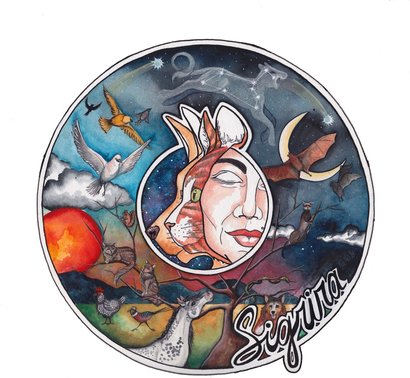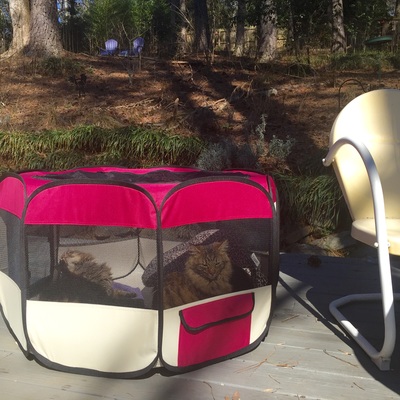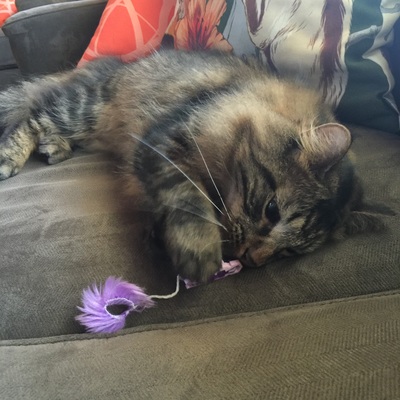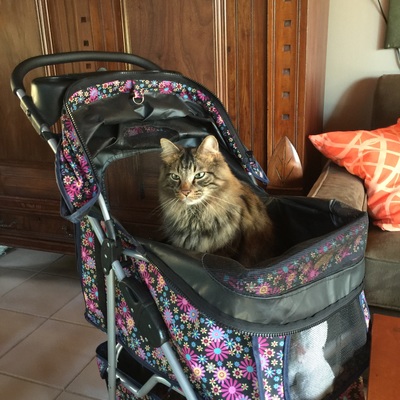|
One of the big issues that affects companion animals is boredom. It may sound trivial but it is a pretty big deal. When an animal is bored and/or lonely, just like humans, this can lead to depression, lethargy or destructive behavior. As with anything else, always remember that animals have rich inner emotional lives, like us. We adore our furkids, but the reality is that many of us have to work outside our home at least five days a week, 40 + hours. This means that when we get home, exhausted and only wanting to eat and sit on the couch, kitty (or dog, rat, bunny etc) has been home alone and is in desperate need of attention and playing. You have a whole life/career outside the home, they only have you.
From your cat or dog’s perspective, the reason for needing to play is twofold: 1. They want to play for fun, to alleviate boredom and because there is an instinctive desire to chase, hunt, scratch, dig etc. 2. They can sense your energy and want to elevate your mood, they want to engage you in an activity that will lighten and help you as well. From an energy perspective they are more aware than most humans. When you consider what your cat needs, think about/research what a cat (even a big cat, like a lion) does in the wild. They have social interactions, they run, they hunt. Obviously indoor kitties don’t get to really “hunt” except maybe an occasional insect, but this is where environmental enrichment comes in. This is a concept that is regularly used in zoos and other establishments where wild animals are kept in captivity. The goal is to create an environment filled with activities that replicate what they would want to do in the wild. It is well worth looking it up online and/or buying a few books about it. (I am researching books now and will post in my “recommended books” section soon.) For example, we recently purchased these little robotic insect toys that are battery operated, and our kitties go wild “hunting” them. They stalk them, chase them, throw them in the air and basically do all the things they would do if they had captured live prey. This satisfies a very deep instinctual need. When our first cat sons were older, I noticed sometimes they would want to play before eating, in a way recreating the natural order of hunting before devouring their food. Some cats like running wheels (like the wheels traditionally seen in hamster habitats, but big enough for a cat.) Because our animal companions are very intelligent (remember intelligence should never be measured by human expectations) even interactive play should be challenging and adapted to your furkid. For example, dangling a ribbon for my cat son gets boring for him after a while, and he prefers the ribbon to disappear under something, like a pillow, so he can dive under it to retrieve it. There is no “one size fits all” method of play. The ideal is to spend enough time with your animal and try different things in order to see what they respond to. There are also things you can do when you are away from home, like leaving treats hidden in places for them to find (there are treat dispensing toys too.) It is also wonderful if possible to adopt two (or more) animals instead of one so that they have each other for companionship while you are away from home. Dogs also have strong instincts that shape their preferred method of play. For example dogs that love digging can be intellectually stimulated by hiding treats in areas of your garden where they are allowed to dig. (this will save the plants you want to keep, too.) Some dogs love to play fetch and others need to play in water, in which case you can provide a kiddie pool and sprinklers. Be careful if they eat their toys to supervise this so they don’t ingest anything dangerous. Dogs need to walk and/or run daily too, preferably with their people, or with a dog walker if you don’t have time everyday. Both dogs and cats feel a need to be in sunshine and nature. This is easier to provide for dogs if your cats are indoors only, but there are still options. Cats can have outdoor enclosures (catios) or temporary screened in play pens. Some also like to go out on harnesses/leashes or in cat strollers. At the very least provide open windows for fresh air (with strong screens so they can’t fall out.) I focused on cats and dogs, but all companion animals need this, whether you have rabbits, birds or rats. Animals that live in cages need even more one-on –one time outside their enclosure to combat boredom and depression. Part of being a great animal parent is to provide for their emotional happiness as well as their physical safety and health. Please make sure to allow time to play and to enrich their environment. They will understand if sometimes you simply are very busy, but in that case talk to them and tell them when you will be able to play. For example:”I’m sorry I have to type up a presentation for work right now, but in a few hours, when I finish, we can go to the park.” Most importantly, when you do this, always keep your promises. Comments are closed.
|
Archives
January 2021
|
|
|
©2013-2025 Sigrira, LLC,




 RSS Feed
RSS Feed